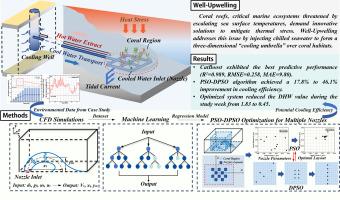通过集成的机器学习和粒子群优化算法探索井涌缓解珊瑚白化的潜力
IF 4.4
2区 工程技术
Q1 ENGINEERING, OCEAN
引用次数: 0
摘要
珊瑚礁是受到海平面温度上升威胁的重要海洋生态系统,需要创新的解决方案来减轻热应力。本研究介绍了一种新颖的上升井(Well-Upwelling, WU)系统,该系统战略性地注入冷却海水,在珊瑚栖息地上方形成三维冷却保护伞。喷嘴参数和布局通过利用计算流体动力学(CFD)、机器学习(ML)和混合粒子群优化(PSO-DPSO)框架进行优化。实验证明,CatBoost在预测射流动力学方面具有优势,能够有效优化喷嘴直径(d0)、出口速度(u0)和离散布局。在中国南山港附近的一个案例研究中,在2024年发生了严重的热应力(度加热周,DHW > 8),结果表明,与随机布局相比,集成PSO-DPSO算法将冷却效率提高了17.8 - 46.1%,确定了平衡效率和热保持的最佳参数(u0 = 0.20 m/s, d0= 0.21 m)。值得注意的是,基于模拟的结果表明,优化后的系统在研究期间将珊瑚区的DHW值从1.83降低到0.45,对应于平均温度降低1.38±0.073℃,低于引起可见珊瑚应力的阈值(DHW = 1)。这项工作为水动力优化建立了一个可扩展的、数据驱动的框架,证明了WU系统通过有效减少动态海洋环境中的热应力来减轻珊瑚白化的潜力。本文章由计算机程序翻译,如有差异,请以英文原文为准。

Exploring the potential of well-upwelling for coral bleaching mitigation via integrated machine learning and particle swarm optimization algorithms
Coral reefs, critical marine ecosystems threatened by escalating sea surface temperatures, demand innovative solutions to mitigate thermal stress. This study introduces a novel Well-Upwelling (WU) system that strategically injects chilled seawater to form a three-dimensional cooling umbrella over coral habitats. Nozzle parameters and layouts are optimized by leveraging computational fluid dynamics (CFD), machine learning (ML), and a hybrid Particle Swarm Optimization (PSO-DPSO) framework. Categorical Boosting (CatBoost) was validated as superior for predicting jet dynamics, enabling efficient optimization of nozzle diameter (d0), exit velocity (u0), and discrete layouts. A case study near Nanshan Harbor, China—where severe heat stress occurred in 2024 (Degree Heating Weeks, DHW > 8)—revealed that the integrated PSO-DPSO algorithm improved cooling efficiency by 17.8–46.1 % compared to random layouts, identifying optimal parameters (u0 = 0.20 m/s, d0= 0.21 m) that balanced efficiency and thermal retention. Notably, the simulation-based results indicate that the optimized system reduced the DHW value during the study period from 1.83 to 0.45 in the coral region, corresponding to a 1.38±0.073℃ decrease in average temperature—below the threshold (DHW = 1) that induces visible coral stress. This work establishes a scalable, data-driven framework for hydrodynamic optimization, demonstrating the WU system’s potential to mitigate coral bleaching by effectively reducing thermal stress in dynamic marine environments.
求助全文
通过发布文献求助,成功后即可免费获取论文全文。
去求助
来源期刊

Applied Ocean Research
地学-工程:大洋
CiteScore
8.70
自引率
7.00%
发文量
316
审稿时长
59 days
期刊介绍:
The aim of Applied Ocean Research is to encourage the submission of papers that advance the state of knowledge in a range of topics relevant to ocean engineering.
 求助内容:
求助内容: 应助结果提醒方式:
应助结果提醒方式:


